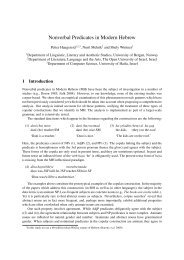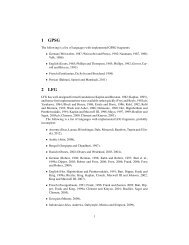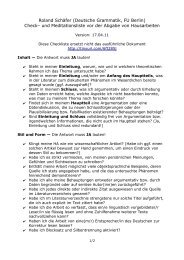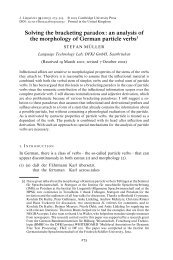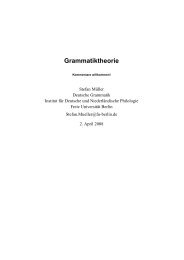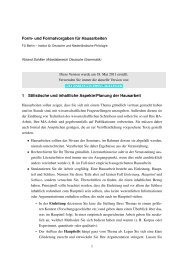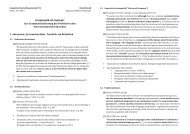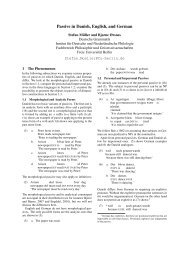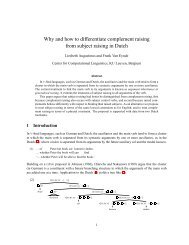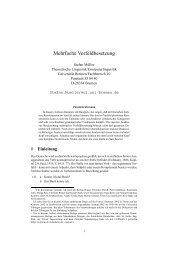Danish in Head-Driven Phrase Structure Grammar - German ...
Danish in Head-Driven Phrase Structure Grammar - German ...
Danish in Head-Driven Phrase Structure Grammar - German ...
You also want an ePaper? Increase the reach of your titles
YUMPU automatically turns print PDFs into web optimized ePapers that Google loves.
Object Shi and Negation Shi<br />
d. Men den kommende viceborgmester i Mariager Fjord Kommune har<br />
but the future vice.mayor <strong>in</strong> Mariager Fjord municipality has<br />
[<strong>in</strong>tet] fortalt s<strong>in</strong> partiformand, der nu venter på en forklar<strong>in</strong>g <br />
noth<strong>in</strong>g told his party.leader who now waits for an explanation<br />
‘But the future vice mayor <strong>in</strong> Mariager Fjord municipality has not told his<br />
leader <strong>in</strong> the party anyth<strong>in</strong>g and he is now wait<strong>in</strong>g for an explanation’<br />
is differs from object shi where shi over the f<strong>in</strong>ite verb is impossible (see Section<br />
... on Holmberg’s Generalization). Engels (: p. ) calls this shi<strong>in</strong>g over<br />
the f<strong>in</strong>ite verb the Inverse Holmberg Effect.<br />
e DO can also neg-shi if it <strong>in</strong>dependently occurs <strong>in</strong> a position adjacent to the<br />
negation, because the <strong>in</strong>direct object has shied to the position before the sentential<br />
adjuncts as <strong>in</strong> (a) (Christensen : p. ). In this laer case the Neg-shi is str<strong>in</strong>gvacuous:<br />
you cannot tell from the sequence of words whether the IQP is <strong>in</strong> the position<br />
of the negation or <strong>in</strong> complement position with<strong>in</strong> the VP. However, s<strong>in</strong>ce an IQP is<br />
impossible – or extremely marked – <strong>in</strong> complement position (see example (b)), we have<br />
strong <strong>in</strong>dications that the IQP <strong>in</strong>gen penge (‘no money’) <strong>in</strong> example (a) has <strong>in</strong>deed<br />
undergone neg-shi.<br />
() a. De lånte [hende] i faktisk [<strong>in</strong>gen penge j ] _ i _ j<br />
they lend her actually no money<br />
‘Actually they didn’t lend her any money.’<br />
b. ?* Jeg låner m<strong>in</strong> bror [<strong>in</strong>gen penge]<br />
I lend my brother no money<br />
‘I am not lend<strong>in</strong>g my brother any money.’<br />
If neither of these two conditions is met, an IQP as a DO cannot undergo neg-Shi as<br />
shown <strong>in</strong> ().<br />
()<br />
* Jeg låner [<strong>in</strong>gen penge] [m<strong>in</strong> bror]<br />
I lend no money my brother<br />
‘I am not lend<strong>in</strong>g my brother any money.’<br />
A neg-shied complement cannot conta<strong>in</strong> any post-nom<strong>in</strong>al modifiers (Christensen :<br />
p. ). e shied constituent must be syntactically light. Neg-shi<strong>in</strong>g strands postnom<strong>in</strong>al<br />
modifiers <strong>in</strong> the canonical position of the complement. Interest<strong>in</strong>gly strand<strong>in</strong>g<br />
of post-nom<strong>in</strong>al modifiers is generally not possible outside neg-shi<strong>in</strong>g contexts.<br />
In (a) the object <strong>in</strong>gen <strong>in</strong>dflydelse (‘no <strong>in</strong>fluence’) has shied leav<strong>in</strong>g the PP-modifier<br />
på de beslutn<strong>in</strong>ger (‘on those decisions’) with<strong>in</strong> the VP. Example (b) shows that the<br />
PP cannot shi along with the object and example (c) shows, that post-nom<strong>in</strong>al PPs<br />
cannot be stranded outside neg-shi, e. g. if the head-noun is topicalized.<br />
http://www.bt.dk/krimi/viceborgmester-i-slagsmaal-med-doermand, / <br />
<br />
Dra of October , , :




